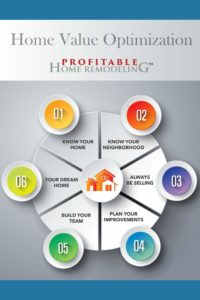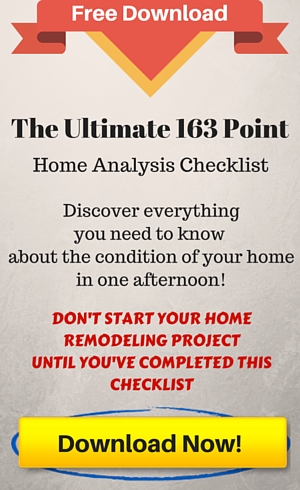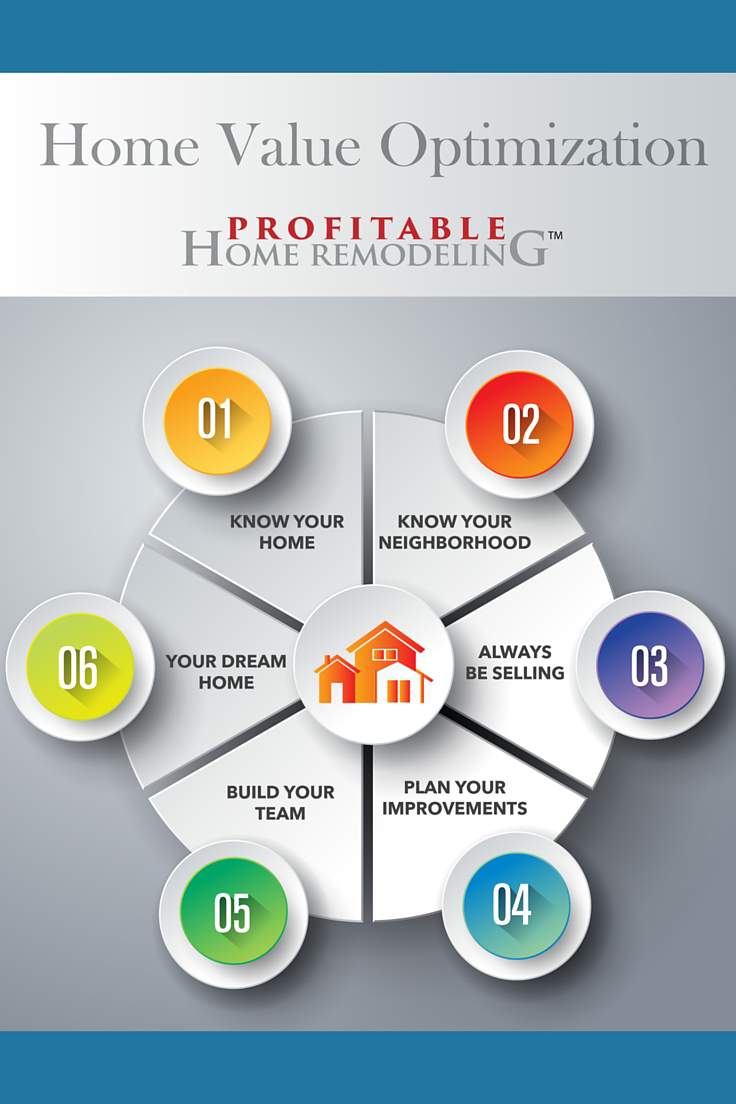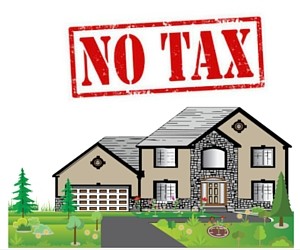Home Value Optimization
Your Home is an Investment. . .
IT'S NOT A SECRET BUT. . . .
- You won’t learn this stuff when you buy a home.
- You won’t hear it from the ‘Big Box’ retailers selling you paint, expensive new carpet, bathroom vanities, shinny appliances, kitchen cabinets, or riding lawn mowers.
- Your real estate agent or mortgage broker probably didn’t tell you this when you bought or sold your home either.
- Your contractor, plumber, handyman, landscaper or lawyer didn’t tell you these strategies either.
It's not their fault!
These are all well meaning professionals doing their jobs.
So it’s up to you to realize this and get started learning how to make homeownership work for you.
The process for building value into your home is simple:
- Know Your Home
- Know Your Neighborhood
- Always Be Selling
- Plan Your Improvements
- Build Your Team
- Find Your Dream House
This resource is designed for homeowners.
Any homeowner planning to remodel, who wants to build value into their home. . .
But doesn’t know where to start.
You see, we believe all homeowners are investors.
Often stuck not having a strategy designed to build value in
their home, and not knowing how to capitalize on that value.
There’s just so many ways to turn.
This page is here to help you learn how to develop a strategy to optimize the value of the investment in your home.
A strategy that can, over time, also help you build your family's net-worth.
The New York Times recently put it this way:
"Homeownership long has been central to Americans’ ability to amass wealth; even with the substantial decline in wealth after the housing bust, the net worth of homeowners over time has significantly outpaced that of renters, who tend as a group to accumulate little if any wealth.”
The No-Tax Capital Gains Secret!
Many homeowners simply don't know this program exists.
It can and will help you build value in your home and build wealth for your family.
"UNCLE SAM" steps up to help homeowners.
Back in 1997 Uncle Sam decided to give ordinary American homeowners a break with the passage of the Tax Relief Act of 1997.
The history of the provision is not important, except to say this is one of the biggest tax breaks any homeowner could use, because it lets you build wealth tax free.
But before I get ahead of myself there's also a caution, this Tax Relief is offered by our friends at the I.R.S. and that means there are strict rules that have to be followed. So be sure to consult your own tax adviser for the details.
With that said, a homeowners, just like you, can and do use this provision of the tax code to build wealth TAX FREE using their homeownership.
Our friends over at Trulia.com put it this way:
“The Relief Act allows sellers to sell their property as long as they have lived there for 2 of the last 5 years and take advantage of this tax relief. For single individuals, they can realize up to $250,000 in capital gains TAX FREE.
For married couples, it is $500,000. There is no requirement to roll these proceeds over to a replacement home, so a seller can take this money and go on a cruise around the world if they so desire.
Additionally, there is no limit to the number of times you can use this exemption. You just need to make sure you have lived in the home as your primary residence for two of the past five years.”
This is a huge opportunity!
With the proper strategies, a little planning, and some hard work you could own your dream home free and clear in just a few short years.
Here's proof from one of debt management guru Dave Ramsey's' students:
"Fourteen years ago, Lorena Mejia was a single mom with two young kids, and she was working three jobs a day to pay a “terrible mortgage” she could barely afford.Today, she’s the proud owner of a four-bedroom home she paid cash for."
Making It Work to Build Your Wealth.
This plan is not for every family.
Building wealth is not as easy as playing the lottery.
You're going to have to want it, and be willing to put in time and effort.
Learning, working and planning to make it happen for your family.
You're going to have to make some sacrifices too.
While the process is simple you need to be determined and patient at the same time.
- First you must meet all the I.R.S qualifications - Primarily - Live in your home for 2 of the last 5 years.
- Build value in your home by systematically remodeling, maintaining, and beautifying your home. Keep records and receipts of everything. (Your accountant will need them)
- Plan your next home purchase. Begin today looking for a nicer home in a better neighborhood. Spend time shopping, investigating, and talking to real estate professionals who know your target neighborhood. Think small house in great neighborhood. There are always 'semi-distressed' home reasonably priced that just need some DIY help.
- Pay down your existing mortgage as fast as possible. Keeping track of your homes value and the equity you've built.
- When the circumstances are right, sell your existing home and use the equity to purchase your new home. This can be tricky, but there are many ways to make this happen.
- Continue the process until you own your Dream Home free and clear.
We Call this process Home Value Optimization or HVO.
It’s the same plan many of America’s wealthiest families used to build their net-worth.
It’s the same plan that real estate developers have used to transform neighborhoods.
It’s the same plan savvy house flippers have used across America to build fortunes.
The "HVO" process can work for first time homeowners and long time property owners.
This process works because you’re planning to add value to your home.
You'll be making smart choices in maintenance, landscaping, and remodeling.
And you’re building a strong community, one that other people will want to live in.

 Before You Begin!
Before You Begin!
 This graphic outlines the steps of HVO.
This graphic outlines the steps of HVO.
Print your copy and keep it handy.
As you work through the various Home Value Optimization checklists and execution plans (see sections below) you’ll want to remind yourself of the process.
This is a warning: There is little profit in simply understanding, for example, the Tax Benefits of homeownership, knowing your home, planning your improvements, selecting the right contractor, or how to upgrade to your dream home in and of itself.
There is however, enormous value, and profit, in understanding how and when to apply these homeowner strategies.
The first concept you need to embrace is :
Profitable Home Remodeling™ is a process and not a race.
You must keep your focus on building value in your home. Then planning your next move.
Otherwise, you’re likely to waste your time and money on the next trending idea, design, color, or must have home improvement gadget that catches your attention.
Here's the start to Home Value Optimization and The Profitable Home Remodeling ™ system….
GET STARTED NOW. . . .
Home Value Optimization
Step 1 - Know Your Home.
According to a National Association of Reators survey, “The majority of home buyers (77%) had a home inspection prior to purchasing their home”.
You should have reviewed this document at the time of your home purchase, and addressed any issues that were identified.
Now that you're planning to remodel, you should complete your own home analysis.
Doing so will give you first-hand knowledge about the condition of your home and it’s major systems.
Once completed, this analysis will help you determined the overall health of your home.
It will also help you determine where to start on your remodel plans. So that you build value into your home while you increase the liveability.
We've created a FREE checklist to get you started.
Grab your Free copy of our Ultimate 163 Point Home Analysis Checklist HERE
Step 2 - Know Your Neighborhood
One of the most influential factors in the the value of your home is location.
According to Quicken Loans Chief Economist Bob Walters.
"Every city, and every neighborhood, moves in different directions based on local factors. Consumers need to remember to watch their local area closely to understand the direction their market is heading"
Among the neighborhood factors that influence the value of your home are: School district, Parks and access to recreation areas, roads and highway access, police and fire protection, crime rates, rental percentage. Understanding these factors can give you valuable insight into how to build the value of your home.
Smart homeowners also keep track of the "Comp" value of their home. Think of this like Monopoly, where you are on the board matters. As does the current selling price of other homes in your neighborhood.
Real Estate website Zillo.com defines comps this way:
"Comps, or comparables, are regarded as the single-best tool in determining a home's value. They contrast criteria from recently-sold properties in a neighborhood, such as sale price, age of house, size, and square footage."
With the help of the internet, and your favorite real estate agent, you can determine the "value" of specific home features - and how they increase or decrease the value of homes in your neighborhood.
For example in a given neighborhood a pool may be a 'must have' to get the best selling price for your home, while in another it could be number of bedrooms, bathrooms, or something else entirely.
Fully understanding your neighborhood will help you determine how to build value into your home year after year.
Step 3 - Always Be Selling
"It's all about first impression, no question about that,"
"When I'm sitting with my buyers in my car and we pull up to a home, if it doesn't look halfway decent, my buyers in many cases say, 'John let's take a pass on this, because I just don't like the outside.' He further explained ‘Buyers typically assume that if the exterior of the house hasn't been maintained, then the interior hasn't either,"
John Kmiecik, regional vice president for the National Association of Realtors and
a Chicago-area real estate agent put it this way in an article by CBS Money Watch.
"Like it or not your home is a reflection of the effort and care you've put into it, and that is most visible on the outside.
Not only do people see your home when they're driving your street. There looking at you from afar as well."
As a homeowner who will at some point in time seek to get the highest sale price for your home this is a good thing. It is never too early to start marketing your home.
Additionally, with today's technology most home buyers start on the Internet. According to the National Association of Realtors® 2014 PROFILE OF HOME BUYERS AND SELLERS
- For 43 percent of home buyers, the first step in the home-buying process was looking on-line for properties
- Ninety-two percent of buyers use the Internet in some way in their home search process
- 50 percent of buyers use a mobile website or application in their home search
Zillow.com, Trulia.com, Realtor.com, Goggle Maps, and Goggle Earth are only a fraction of the sites showing or listing your home on the internet.
Many of these sites even have pictures of your home. Often out-dated and sometimes taken out-of-season when your home looks it's worst.
As a homeowner you need to control the information that is being published about your home online.
The whole process starts with curb appeal, as the old saying goes:
"You Never Get a Second Chance to Make a First Impression"
Your home is a sizeable investment, and there is no telling what life will bring on any given day. That brings us to the old Scouting Motto: Always be Prepared.
For a homeowner, seeking to build value in your home, that means prepared to sell.
The reasoning is simple, there is always a time and price at which it makes sense for you to move on.
The IRS requires you live in your home a minimum of 2 of the last 5 years prior to the sell of your home in order to qualify for the Tax Relief Act of 1997.
That said, there is no time like the present to prepare for that day.
The Ultimate 163 Point Home Analysis
Is your home ready for a remodel?
Use this The Ultimate 163 Point Home Analysis Checklist to determine if your home is ready for a remodel.
This checklist guides through all the major areas of your home and helps you determine if all the necessary repair and maintenance task have been completed.
- After completion you will have a thorough understanding of our home.
- You'll also be able to start your home remodel project with the confidence of knowing everything is ready to go.
Download your free copy of the Ultimate 163 Point Home Analysis Checklist. In less than one weekend you can start your remodel with confidence.

Get Started with The Ultimate 163 Point Home Analysis Checklist
Enter your name and email below:
We value your privacy and your information is 100% safe



